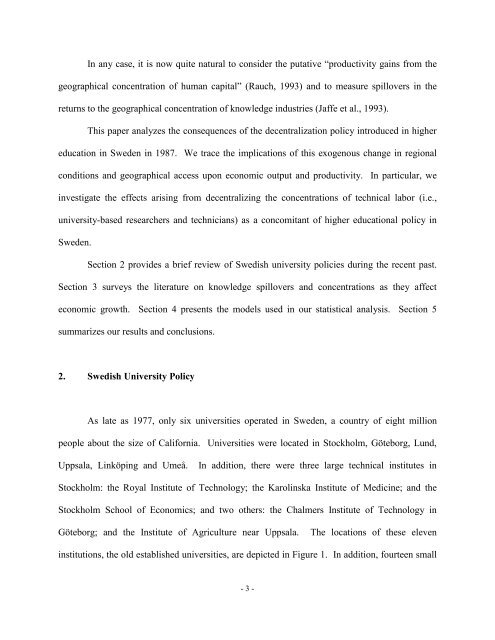Effects of Universities on Regions´ Economic Development
Effects of Universities on Regions´ Economic Development
Effects of Universities on Regions´ Economic Development
You also want an ePaper? Increase the reach of your titles
YUMPU automatically turns print PDFs into web optimized ePapers that Google loves.
In any case, it is now quite natural to c<strong>on</strong>sider the putative “productivity gains from the<br />
geographical c<strong>on</strong>centrati<strong>on</strong> <str<strong>on</strong>g>of</str<strong>on</strong>g> human capital” (Rauch, 1993) and to measure spillovers in the<br />
returns to the geographical c<strong>on</strong>centrati<strong>on</strong> <str<strong>on</strong>g>of</str<strong>on</strong>g> knowledge industries (Jaffe et al., 1993).<br />
This paper analyzes the c<strong>on</strong>sequences <str<strong>on</strong>g>of</str<strong>on</strong>g> the decentralizati<strong>on</strong> policy introduced in higher<br />
educati<strong>on</strong> in Sweden in 1987. We trace the implicati<strong>on</strong>s <str<strong>on</strong>g>of</str<strong>on</strong>g> this exogenous change in regi<strong>on</strong>al<br />
c<strong>on</strong>diti<strong>on</strong>s and geographical access up<strong>on</strong> ec<strong>on</strong>omic output and productivity. In particular, we<br />
investigate the effects arising from decentralizing the c<strong>on</strong>centrati<strong>on</strong>s <str<strong>on</strong>g>of</str<strong>on</strong>g> technical labor (i.e.,<br />
university-based researchers and technicians) as a c<strong>on</strong>comitant <str<strong>on</strong>g>of</str<strong>on</strong>g> higher educati<strong>on</strong>al policy in<br />
Sweden.<br />
Secti<strong>on</strong> 2 provides a brief review <str<strong>on</strong>g>of</str<strong>on</strong>g> Swedish university policies during the recent past.<br />
Secti<strong>on</strong> 3 surveys the literature <strong>on</strong> knowledge spillovers and c<strong>on</strong>centrati<strong>on</strong>s as they affect<br />
ec<strong>on</strong>omic growth. Secti<strong>on</strong> 4 presents the models used in our statistical analysis. Secti<strong>on</strong> 5<br />
summarizes our results and c<strong>on</strong>clusi<strong>on</strong>s.<br />
2. Swedish University Policy<br />
As late as 1977, <strong>on</strong>ly six universities operated in Sweden, a country <str<strong>on</strong>g>of</str<strong>on</strong>g> eight milli<strong>on</strong><br />
people about the size <str<strong>on</strong>g>of</str<strong>on</strong>g> California. <str<strong>on</strong>g>Universities</str<strong>on</strong>g> were located in Stockholm, Göteborg, Lund,<br />
Uppsala, Linköping and Umeå. In additi<strong>on</strong>, there were three large technical institutes in<br />
Stockholm: the Royal Institute <str<strong>on</strong>g>of</str<strong>on</strong>g> Technology; the Karolinska Institute <str<strong>on</strong>g>of</str<strong>on</strong>g> Medicine; and the<br />
Stockholm School <str<strong>on</strong>g>of</str<strong>on</strong>g> Ec<strong>on</strong>omics; and two others: the Chalmers Institute <str<strong>on</strong>g>of</str<strong>on</strong>g> Technology in<br />
Göteborg; and the Institute <str<strong>on</strong>g>of</str<strong>on</strong>g> Agriculture near Uppsala. The locati<strong>on</strong>s <str<strong>on</strong>g>of</str<strong>on</strong>g> these eleven<br />
instituti<strong>on</strong>s, the old established universities, are depicted in Figure 1. In additi<strong>on</strong>, fourteen small<br />
- 3 -








